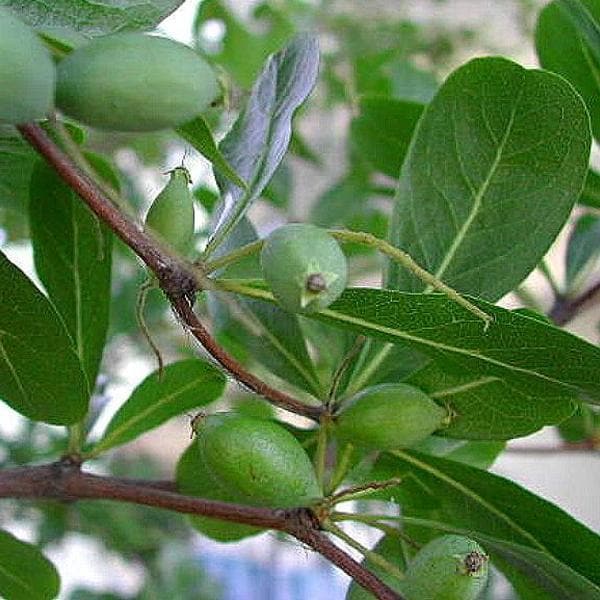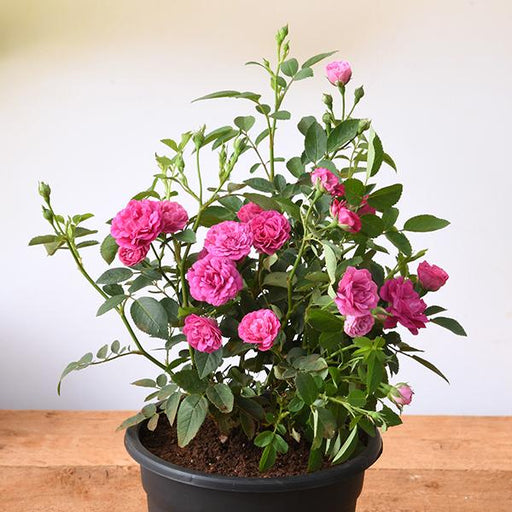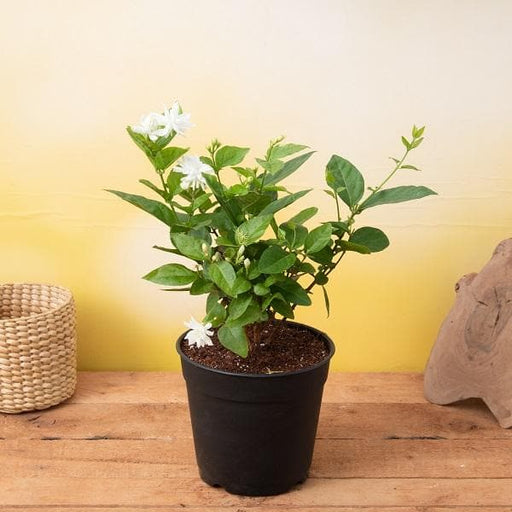
Madagascar Almond, Mini Badam, Terminalia mantaly - Plant
(MRP Inclusive of all taxes)
- Shipping ₹79 for entire order
- Dispatch in 7 days
- Country of origin: India

(MRP Inclusive of all taxes)
 Save 29%
Save 29%
Air Purifier Money Plant with Pot The Air Purifier Money Plant, also known as Pothos or Epipremnum aureum, is a stunning indoor plant that...
View full details
 Save up to 15%
Save up to 15%
Peace Lily, Spathiphyllum - Plant The Peace Lily, scientifically known as Spathiphyllum, is a stunning houseplant celebrated for its elegant white...
View full details
 Save 25%
Save 25%
Jasminum sambac, Mogra, Arabian Jasmine - Plant Jasminum sambac, commonly known as Mogra or Arabian Jasmine, is a fragrant flowering plant...
View full details
 Save 18%
Save 18%
Combo Constituents Includes the Parijat Tree (Night-Flowering Jasmine), a culturally significant plant with fragrant flowers. Description The Pari...
View full details
 Save 25%
Save 25%
Miniature Rose, Button Rose (Any Color) - Plant The Miniature Rose, also known as the Button Rose, is a charming and compact flowering plant that ...
View full details Save 25%
Save 25%
Damascus Rose, Scented Rose (Any Color) - Plant The Damascus Rose, also known as Rosa damascena, is a timeless symbol of beauty and romanc...
View full details
 Save 17%
Save 17%
Beautiful Fragrant Mogra, Arabian Jasmine Plant with Pot The Beautiful Fragrant Mogra, also known as Arabian Jasmine (Jasminum sambac), is...
View full details Save 15%
Save 15%
Pack of Vermicompost and Neem Cake for House Plants Transform your indoor garden with our premium Pack of Vermicompost and Neem Cake, spec...
View full details
Pack of Plant Growth and Flower Boosters Unlock the full potential of your garden with our Pack of Plant Growth and Flower Boosters! This ...
View full details Save 38%
Save 38%
Combo of Jeevamrut and Neem Raksha for Easy Growth and Protection of Houseplants Transform your indoor garden with our exclusive combo of ...
View full details Save 22%
Save 22%
Plant Nutrients Kit (Pack of 16) for a Healthy Garden Transform your garden into a lush paradise with our Plant Nutrients Kit, featuring 1...
View full details Save 16%
Save 16%
Combo of Top Plant Fertilizers Elevate your gardening game with our exclusive Combo of Top Plant Fertilizers, featuring two bags of premiu...
View full details Save 24%
Save 24%
Pack of 4 Additives to Make Soil Healthy and Nutrient Rich Transform your garden into a thriving ecosystem with our Pack of 4 Additives de...
View full details Save 30%
Save 30%
Transform your gardening experience with our premium Combo of Perlite and Vermiculite. This unique blend is designed to enhance soil aeration and ...
View full details Save 27%
Save 27%
Combo of 2 Vermicompost and Cocopeat - Enrich Your Soil Naturally! Transform your garden into a thriving ecosystem with our Combo of 2 Ver...
View full details
 Save 35%
Save 35%
Best 6 Plants for Perfect Indoor Garden Transform your living space into a lush oasis with our curated collection of the Best 6 Plants for a...
View full details
 Save up to 50%
Save up to 50%
Mini Succulent Garden Pack Transform your space with our Mini Succulent Garden Pack, featuring a delightful collection of 4 any variety beautiful s...
View full details
 Save 30%
Save 30%
5 Best Fragrant Plants Transform your garden or indoor space into a fragrant paradise with our curated selection of the 5 Best Fragrant Plants. Th...
View full details
 Save 24%
Save 24%
Set of 2 Bonsai Looking Grafted Adeniums Transform your indoor or outdoor space with our exquisite Set of 2 Bonsai Looking Grafted Adenium...
View full details Save 45%
Save 45%
Top 4 Die Hard Succulents Pack Transform your indoor or outdoor space with our Top 4 Die Hard Succulents Pack, featuring a curated selecti...
View full details
 Save 30%
Save 30%
5 Best Indoor Plants Pack Transform your living space into a lush oasis with our '5 Best Indoor Plants Pack.' This carefully curated collection fe...
View full details
 Save 25%
Save 25%
Set of 4 Evergreen Air Purifier Plant Pack Transform your indoor space into a lush, green oasis with our Set of 4 Evergreen Air Purifier Pla...
View full details| SrNo | Item Name | Qty |
|---|---|---|
| 2 | Madagascar Almond, Mini Badam, Terminalia mantaly Plant | 1 |
The Madagascar Almond, scientifically known as Terminalia mantaly, is a stunning tropical tree native to Madagascar. This evergreen marvel is celebrated for its unique, glossy leaves and striking, almond-shaped fruits. With its ability to thrive in various soil types, it is an excellent choice for both ornamental and functional landscaping. The Madagascar Almond not only enhances the beauty of your garden but also contributes to biodiversity, making it a valuable addition to any green space.
What makes the Madagascar Almond special is its resilience and adaptability. This tree can grow in a range of climates, from tropical to subtropical, and is known for its impressive growth rate. Its beautiful foliage provides shade and habitat for various wildlife, promoting ecological balance. Additionally, the nuts produced by the tree are edible and can be used in various culinary applications, making it a dual-purpose plant.
One of the standout features of the Madagascar Almond is its striking appearance. The tree can reach heights of up to 30 feet, with a broad canopy that offers ample shade. Its unique bark and vibrant green leaves make it a focal point in any landscape. Furthermore, the nuts are rich in nutrients, providing a sustainable food source for both humans and wildlife.
If you think almonds are just for snacking, think again! Madagascar Almond, or Mini Badam, is a powerhouse of nutrients. Packed with healthy fats, fiber, and protein, these little gems can boost your heart health and keep your skin glowing. Plus, they’re a great source of antioxidants, which means they’re like tiny superheroes fighting off free radicals. So, munch away guilt-free, knowing you’re doing your body a favor while enjoying a crunchy treat!
Caring for your Terminalia mantaly is like raising a child—except this one doesn’t throw tantrums! This resilient tree thrives in various conditions, making it a low-maintenance companion. Just give it a sunny spot, some well-drained soil, and a sprinkle of water, and watch it flourish. It’s the perfect plant for those who want to feel like a gardening guru without the stress of a high-maintenance diva!
Watching a Madagascar Almond tree grow is like witnessing a slow-motion miracle. These trees can reach impressive heights, providing shade and beauty to your garden. With a growth rate that’s as steady as a tortoise, patience is key. But once it’s established, it’ll reward you with a stunning canopy and a bounty of delicious nuts. So, grab your gardening gloves and prepare for a long-term relationship with this majestic tree!
just pluck the nuts from the tree and enjoy the satisfaction of your hard work. Whether you’re snacking on them or using them in recipes, the joy of harvesting your own almonds is unmatched. Plus, you can impress your friends with your newfound farming skills!
Want to be the eco-warrior of your neighborhood? Planting Terminalia mantaly is a step in the right direction! This tree not only beautifies your space but also contributes to biodiversity and soil health. Its deep roots help prevent erosion, making it a sustainable choice for your garden. So, while you sip your organic tea, you can feel good knowing you’re doing your part for Mother Earth!
Let’s talk numbers! Madagascar Almonds are not just tasty; they’re also packed with nutritional value. With a healthy dose of vitamins, minerals, and healthy fats, they’re a snack that’s good for your body and soul. They can help lower cholesterol, improve brain function, and even support weight management. So, next time you reach for a handful, remember you’re indulging in a guilt-free treat that’s as nutritious as it is delicious!
If you’re looking to elevate your landscaping game, Terminalia mantaly is your secret weapon. This tree adds a touch of elegance and sophistication to any garden. Its lush foliage and striking form make it a standout feature, whether planted alone or in groups. Plus, it provides shade for those hot summer days, making your outdoor space the go-to spot for relaxation. Who knew landscaping could be this chic?
Get ready to unleash your inner chef with Madagascar Almonds! These versatile nuts can be incorporated into a variety of recipes, from salads to desserts. Toss them in a stir-fry for a crunchy twist or blend them into smoothies for a creamy texture. The possibilities are endless! So, roll up your sleeves and get creative in the kitchen—your taste buds will thank you!
Did you know that Mini Badam is a hit among wildlife? Birds and small mammals love these nuts, making your garden a bustling hub of activity. By planting Madagascar Almond trees, you’re not just beautifying your space; you’re also creating a sanctuary for local wildlife. So, sit back, relax, and enjoy the show as nature’s little critters come to visit your backyard!
Terminalia mantaly isn’t just a pretty face; it has cultural significance too! In Madagascar, this tree is often associated with traditional practices and local folklore. It’s a symbol of strength and resilience, much like the people who cherish it. By planting this tree, you’re not just adding greenery to your garden; you’re connecting with a rich cultural heritage that spans generations.
Madagascar Almonds vs. regular almonds. While both are delicious, Madagascar Almonds pack a unique flavor punch that sets them apart. They’re smaller, crunchier, and have a slightly sweeter taste, making them a delightful addition to your snack repertoire. So, if you’re looking to spice up your nut game, give Mini Badam a try—you won’t be disappointed!
Madagascar Almond, also known as Mini Badam, is a tropical tree that boasts stunning foliage and unique almond-like fruits. Terminalia mantaly is its scientific name, and it’s a showstopper in gardens, providing shade and beauty. Who knew almonds could be so exotic
Caring for Madagascar Almond is a breeze! Just give it well-drained soil, plenty of sunlight, and occasional watering. It thrives in warm climates, so think of it as your tropical vacation plant. Just don’t forget to give it a little love and attention!
While Madagascar Almond prefers the great outdoors, it can be grown indoors if you have a sunny spot. Just remember, it’s a bit of a diva and needs bright light to thrive. So, if your living room is a cave, it might not be the best fit!
Just my exotic Madagascar Almond tree!” Instant cool factor!
Yes, Madagascar Almond is quite the survivor! Once established, it can handle short dry spells like a champ. However, it still appreciates a good drink during prolonged droughts. Think of it as a plant that enjoys a spa day now and then!
Madagascar Almond is a speedy grower, reaching heights of up to 30 feet in ideal conditions. It’s like the Usain Bolt of the plant world! Just give it the right environment, and it’ll be towering over your garden in no time.
While the fruits of Madagascar Almond are technically edible, they’re not exactly gourmet. Think of them as a snack you’d only eat if you were lost in the jungle. Better to admire their beauty than to munch on them!
Madagascar Almond loves warm, tropical climates and isn’t a fan of frost. If you live in a cooler area, consider it a houseplant or a summer fling. It’s all about finding the right environment for this tropical beauty!
Propagating Madagascar Almond is as easy as pie! You can do it through seeds or cuttings. Just plant the seeds in well-draining soil and keep them warm. Soon enough, you’ll have little mini badams sprouting up like eager fans!
Madagascar Almond is generally pest-resistant, but watch out for aphids and scale insects. They can be pesky little critters! A good spray of insecticidal soap or neem oil will send them packing. Your tree deserves a pest-free life!
Absolutely! Madagascar Almond is a fantastic choice for landscaping. Its lush foliage and unique shape make it a standout feature in any garden. Plus, it provides shade, making it the perfect spot for a picnic. Who wouldn’t want to lounge under its branches
Good news for pet parents! Madagascar Almond is considered non-toxic to cats and dogs. So, let your furry friends frolic around this tropical beauty without worry. Just keep an eye on them; you never know when they might decide to dig a hole!